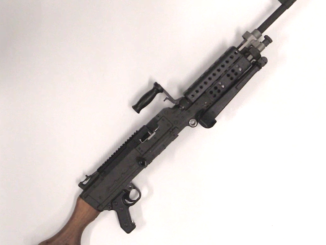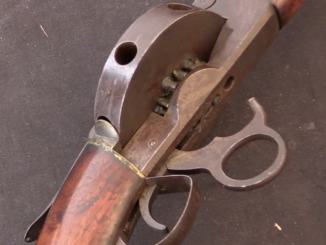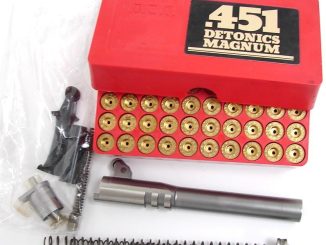Of the seven revolvers Colt named after snakes, the rarest is the Colt Boa. Only a single production run of these were made totaling just 1,200 guns. They were made in 1985 as a custom order for the Lew Horton distribution company, which wanted something unique to offer its buyers. The Boa was an intermediary between the standard Colt MkV and the high-end Python. It was a 6-shot .357 Magnum with a full underlay and ventilated shroud. The only variation was in barrel length, as half were made with 4” barrels and half with 6” barrels. The serial numbers were “BOAxxxx”, with the 4” guns having odd numbers and the 6” ones getting even numbers. Five hundred of each were sold individually, but the first 100 of each length were packaged together into sequentially-numbered pairs in fancy cases.
The Boas all sold in 1985, and they are now the hardest to find for the Colt Snake collector. This particular pair is a gorgeous example of an original cased set, numbers 43 and 44.




what about the Viper????
care to address the “Viper”??
Colt Viper already was covered, see https://www.youtube.com/watch?v=uecvkx2zSyQ please explain why do you think it should be described yet another time.
Uhh, hello?! He already did the Viper half a year ago! Get with the times, man!
It would be nice if Colt reintroduced both the Boa and the Viper. Not to mention the actual King Cobra. What they call the King Cobra today is simply the Colt Magnum Carry snub (a stainless-steel Detective Special in .357) under the more grandiloquent name.
Most of all, they should be affordable, and better thought-out. The Python is nice, but it’s not $1500 worth of “nice”. The same goes for the revamped Anaconda, which still has a trendy “combat” grip that is simply too small for its .44 Magnum cartridge. (Even a .44 Magnum Peacemaker type should have either a Bisley-type grip or at least a Colt 1860 Army-sized “plow handle”, rather than the abbreviated 1851 Navy-sized grip of the Model 1873.)
The Colt Pony was a sensible attempt to appeal to the Cowboy Action Shooting market; a simplified, modernized Model 1873. Their big mistakes were (1) not making it an all-coil-spring design, (2) not making it in .357 and 9 x 19mm in addition to .45 Colt, and (3) doing such a lack-luster job of advertising and marketing it that most customers who would have been interested in it only learned of its existence after Colt had ceased production on grounds of “not enough sales”. All of this was typical of Colt, then and now.
Colt keeps making the same mistakes over and over again. Mostly, trying to appeal to what used to be called the “carriage trade” rather than making revolvers and etc. for the everyday citizen.
Consider that the same “marketing strategy” is why you no longer see revolvers with the Adams, Tranter, Dimancea etc. trademarks.
If not for their contracts to make M16 variants for the Department of Defense, Colt would have disappeared long ago. Because their civilian marketing has been one disastrous misstep after another for the last forty-plus years.
clear ether
eon
“If not for their contracts…” That’s like saying a lion is a pussy cat if not for his class. Handguns are the Colt hobby
From what I understand, the Colt revolvers were basically artisanal, and the majority of the artisans are gone. The ability to produce these pistols at scale is something that evaporated one or two corporate sales ago, and I don’t know if CZ is going to put the money back into training and retaining the guys who are necessary for all the hand fitting and so forth.
The old Colts were works of art. I don’t know what the costs would be to bring them back, but I’d lay you long odds that the sales would likely not work out in favor of actually doing it. Lots and lots of people say they’d buy gun X, but when push comes to shove, and they’re looking at a revolver selling for $2,000.00, they look at it, sigh heavily, and buy something else. The actual buyers never materialize.
It’d be nice, but I don’t think it’s going to happen. The high-end Colts were largely subsidized by the mass-production police revolvers, and those lesser pistols also served as the “farm team” for training the craftsmen who produced the high-end jobs. Without that entire ecosystem? I’m not sure we’re ever going to see these beautiful guns produced again. Sure as hell not affordably, anyway…
Could be wrong, but that’s my take on the idea.
The more I see of Colt and S&W today, the more I realize that most “users” are as well off with something from Ruger and/or Taurus. Hint to C and SW; Coil. Springs. Seriously.
Taurus somehow manages to deliver revolvers with the kind of action and trigger pulls of pre-“short action” S&Ws, and do it in mass production.
Ruger can make just about anything and sell it for a semi-reasonable price. Their only real competition? Taurus in DA revolvers and automatics, and Cimarron and etc. in Peacemaker types.
(BTW, I goofed. The “economy” Colt 1873 was the Colt Cowboy; the Pony was an odd little .380 pocket auto. Mea Culpa, brain fart.)
Getting back to Taurus and Ruger, Taurus now has the Model 692, a seven-shot DA .357 with an interchangeable 9 x 19mm cylinder. The Ruger Single-Six Convertible finally has a competitor, although I notice that several makers of Peacemaker clones, such as (again) Cimarron, are now making 9 x 19mm/ .357 “convertibles” as well.
One noticeable thing is that all of the above sell for a lot less than a Colt or S&W.
Those two need to get with the program. Or else they’re going to end up in the history books right alongside Merwin & Hulbert.
cheers
eon
Much as I like the idea, esthetically? I don’t see high-end revolvers like the old-school Colts and S&W ones coming back. Ever.
From what I understand, the pistols like the Python and Anaconda were built by true craftsmen, who honed their skills working on the lower-grade police service revolvers. The majority of the guys doing the high-end pistols were workmen who’d done literally thousands of other revolvers like the Trooper, and it took decades of experience before they were moved up to the high-end lines, with all the attendant attrition along the way.
Without the extensive ecosystem behind that, I can’t see the old-school high-end revolvers ever coming back as anything other than occasional one-off extremely expensive novelty items. They sure as hell aren’t going to ever get major production numbers back up, and be selling thousands of Pythons a year.
Hell, what were the actual production numbers on those revolvers in the first place?
This is one of those deals where we’re all looking at the idea of bringing the Luger or C96 back into production, wondering why that can’t be affordable with modern CNC, and the answer is quite literally that the designs are inappropriate to that sort of production, and that the craftsmen who made such things affordable are literally dead and buried, beyond our reach. You’d have to go back and rebuild the complete technological ecosystem for DWM and Mauser, in order to do so.
Hell, look at the trials and tribulations that the poor bastards trying to bring the BREN Ten back went through… Somewhere in Arizona, there’s an entire warehouse full of parts that “aren’t quite right”, and the effort has proved out as “Not doable”.
Mass-production of things like firearms ain’t quite as easy as it all looks, from behind your computer screen.
We’re on the same page, here.
You try to build the old Colt Python “the old fashioned way”,today, and your major price-point competitor is going to be the Korth. Which is artisanal to the Maestro die Tierkopfranken level.
What neither one will ever be is a gun kept in a holster for duty, or in a bedside drawer for things that go bump in the night.
Charter Arms had the right idea back in the late 1960s. And the only reason their advanced (and frankly so simple and reliable as to be mule-stupid) design had a chance was the fact that at that point, Colt and S&W were tied up with military contracts.
Some people take the “KISS” principle too far. Do not get me started on the EAA “Windicator” or for that matter mid-1990s Savage 110 rifles. The former were junk, the latter were well-designed but suffered from nonexistent QC.
A good DA .357 revolver should sell for about $600, new. A good SA .357 Peacemaker should sell for about $400.”Convertability” (i.e., also having a properly-fitted 9 x 19mm cylinder) should add another $100 or so in either case. .44 Magnum, with extra .44 WCF cylinder, should be about $100 more in all cases.
Taurus and Cimarron check pretty close to those metrics. Ruger is a bit above them. Colt and S&W don’t have a prayer, at the rate they’re going.
cheers
eon
As for Bren Ten, there’s really no way to shoehorn the .41 Magnum-sized 10mm Auto cartridge into a 9 x 19mm-sized automatic pistol. Especially not one as “skinny” as the CZ75.
The EAA Witness 10mm was built on their scaled-up .45 ACP-sized platform. The Star Megastar 10mm was also their .45 ACP-sized pistol.
Even Colt wasn’t stupid enough to try to build a 10mm Auto on anything smaller than a 1911. Other than Glocks, today the overwhelming majority of 10mm Auto pistols are still 1911s.
Others have made the same mistake. Early in WW2, the British Purchasing Commission pressured John Inglis Co. in Canada to redesign the FN HP for .455in Webley. (!) Why? Because there was no manufacturing capability in Canada for 9 x 19mm ammunition. Cooler heads quickly prevailed, and they started manufacturing 9 x 19mm ammunition in Canada… on machinery imported from Remington-UMC in the United States, who had been making 9mm “Luger” ammunition since just after World War One.
The .40 S&W was the end result of trying to get the 10mm Auto round into 9mm Parabellum-sized pistols. I still regret my role’ in that silly season. Even though I was the one saying they should use it as an opportunity to achieve full-power .357 Magnum performance without having to go the “+P” or “+P+” route, as is required to do it with the much smaller-in-volume 9 x 19mm cartridge envelope.
Instead, they turned it into a .45 ACP “target load”, which in the end was even less powerful than standard-velocity 9mm. Pleasing nobody except a certain agency whose name gets you dumped by the filters here.
The one (admittedly outre’) sort-of-useful byproduct of the “.40 Short & weak” debacle’ was the odd 5-shot snub-nosed revolvers firing .40 S&W with “moon clips”. They were practically a reversion to the short-barreled, big-bore snubnose “Bull Dog” revolvers of a century and a half ago. And due to the effects of their abbreviated barrels on the .40 round, they had about the same unimpressive ballistics. They hit about as hard as a standard-velocity .38 Special, hardly the superior terminal ballistics the .40 was supposed to deliver.
Watson might have found one useful, but no one else ever has.
😉
cheers
eon
I think that a lot of the adulation for “Col Cooper” is misplaced. Yeah, he had a hell of a reputation, but… Some of his ideas? Particularly the BREN Ten? Some of the Scout Rifle stuff?
Best summed up as “Fever Dream”. There is no way in hell you’re going to ever manage out-doing a guy with a G3 or FAL with a bolt-action rifle, and the idea that someone could…? Nope.
I enjoyed his writing. I liked a lot of his reasoning, but I also don’t agree at all with most of it. Left to Jeff Cooper, we’d have the perfect apotheosis of the individual rifleman as our basis for infantry action… Which would wind up as utter failure when put up against realistic use of modern small arms by sensible people who’re fully aware of the psychology and actual capability of the average person.
I do not think that you could possibly get the results he posited out of the human material we had available while I was in the service. Exquisite marksmanship skills are simply not all that common, and I don’t think you could magic them up via some sort of marksmanship training program, either. Men like Alvin York or my Montenegrin friend that could consistently use a surplus 7X57 Mauser to shoot the heads off of quail at 100 yards are just not that common. And, they’re mostly born; not made. You can spend hours a day on a range, practicing, and you’ll see improvement out to the extent of your physical capacity for marksmanship. What you won’t see is the sort of ability to instinctively snap-shoot out to insane ranges that some people have naturally.
Good God… Half the time I went hunting with that Montenegrin, he was spotting game I couldn’t even see once it was pointed out to me. I have no idea what the hell the difference was, but I think a lot of it had to do with him having incredible eyesight, and I swear to God, he could see crap that had to have been out of the range of normal human vision. I talked to him about it, once. He said that there was a “glint”, a certain “look” to animal fur that I just couldn’t pick up on, that made them stand out to him.
That was about the best I could do with explaining it.
Kirk;
I think Cooper himself was one of those one in a million. Elmer Keith was another (read Sixguns by Keith), and most likely Ed McGivern (see Fast and Fancy Revolver Shooting) was a third.
Cooper and Keith made the error of thinking “If I can do it, anybody can, if they practice”. McGivern made no such assumption.
Eric Sykes and William Fairbairn (in Shooting To Live With The One-Hand Gun) emphasized that the techniques there were usable by the average policeman or soldier. How much of that was which one’s contribution is still debated today. (I tend to think it was mostly Sykes; YMMV.)
Ian Hogg once observed (in his book Naval Gun 1974) that at sea or on land, stereoscopic rangefinders were much faster and more accurate than coincidence rangefinders. The drawback was that to use it, the operator had to have a certain degree of stereoscopic vision, and not everybody does. His exact words were, “It’s useless to try to train someone who does not have that stereoscopic vision- I don’t, for one– because they will never be able to make the correct judgement”.
Hogg knew his limitations, as Inspector Callahan would say. Cooper and Keith made the mistake of thinking that their own obviously unusual innate talents or “knacks” were common.
To mix a metaphor, if you don’t have the knack for playing the violin, no matter how much you practice, you’re never going to get to Carnegie Hall.
An army composed exclusively of Jeff Coopers and Elmer Keiths might just be the scariest army ever to march. The trick would be finding that many Coopers and Keiths.
I don’t think there would ever be enough, even with cloning.
And even after literally millennia of the Arisians’ selective breeding program, the Galactic Patrol still never had enough Lensmen to go around.
😉
clear ether
eon
eon, excellent points.
I think the major problem with a lot of the “thinking” in this arena is tied into the egos of the people doing the so-called “thinking”, and that those people are way too invested in their assumptions about reality. They’ve got a worldview, and they’re unable to question it.
I’m a pragmatist; I’ve noted that the “average soldier” isn’t capable or effective with an individual weapon much past 300-400m. It’s not just the marksmanship that’s an issue; it’s predominantly a question of noticing things and being able to identify targets out past that range. If everybody had the ability to do those things, it’d be one thing. Observationally, however? They really don’t.
I don’t think they ever did, either.
This is why I see the “past 400m” combat model differently; I don’t think the individual marksman is either effective or even at all useful at those ranges, which is why I advocate for crew-served and supporting fires to handle those targets. I’d rather be effective than cool, and the idea that my individual rifle guys are going to win the fight at those ranges is ludicrously off the mark. The machinegun is basically a device for producing volley fires effectively, and those are actually what the old-timers were using those rifles for. Not playing Carlos Hathcock “lone rifleman” stuff… Hathcock and York were two extraordinary people with amazing skills that you’re not going to find in the general population. That being a fact, then it’s far more logical to develop your weapons and tactical system to reflect the realities, which don’t include individual riflemen being at all effective past 400m or so.
@ eon
It has to be said that, with the steel-framed Tanfoglio/Witness, you have to be good to spot the differences between the small and large frame pistols, since their dimensions are really almost identical, and the frame is the same for their polymer models. Only the magwell changes.
Looks like a tarted up Trooper Mk.III to me…
Am i the only one who noticed the “SIMPSON LTD xxxxxxxx” marking inside the frame above the serialnumber @2:41 ?
What is that doing there ???
hmmmm
Erudite and on the money‼️
These sets sell for more than fifty thousand dollars. I am glad I won’t be holding that bag.